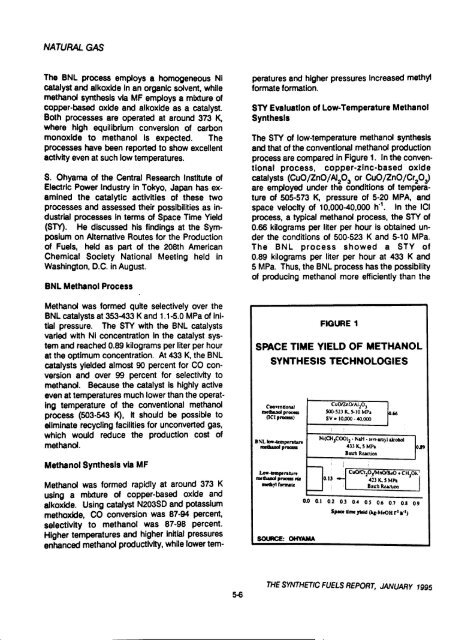Ikelic - Alliance Digital Repository
Ikelic - Alliance Digital Repository
Ikelic - Alliance Digital Repository
Create successful ePaper yourself
Turn your PDF publications into a flip-book with our unique Google optimized e-Paper software.
NATURAL GAS<br />
The BNL process employs a homogeneous Ni<br />
catalyst and alkoxide in an organic solvent, while<br />
methanol synthesis via MF employs a mixture of<br />
copper-based oxide and alkoxide as a catalyst.<br />
Both processes are operated at around 373 K,<br />
where high equilibrium conversion of carbon<br />
monoxide to methanol is expected. The<br />
processes have been reported to show excellent<br />
activity even at such low temperatures.<br />
S. Ohyama of the Central Research Institute of<br />
Electric Power Industry in Tokyo, Japan has ex<br />
amined the catalytic activities of these two<br />
processes and assessed their possibilities as in<br />
dustrial processes in terms of Space Time Yield<br />
(STY). He discussed his findings at the Sym<br />
posium on Alternative Routes for the Production<br />
of Fuels, held as part of the 208th American<br />
Chemical Society National Meeting held in<br />
Washington, D.C. in August.<br />
BNL Methanol Process<br />
Methanol was formed quite selectively<br />
over the<br />
BNL catalysts at 353-433 K and 1 .1-5.0 MPa of ini<br />
tial pressure. The STY with the BNL catalysts<br />
varied with Ni concentration in the catalyst sys<br />
tem and reached 0.89 kilograms per liter per hour<br />
at the optimum concentration. At 433 K, the BNL<br />
catalysts yielded almost 90 percent for CO con<br />
version and over 99 percent for selectivity to<br />
methanol. Because the catalyst is highly active<br />
even at temperatures much lower than the operat<br />
ing<br />
temperature of the conventional methanol<br />
process (503-543 K), it should be possible to<br />
eliminate recycling facilities for unconverted gas,<br />
which would reduce the production cost of<br />
methanol.<br />
Methanol Synthesis via MF<br />
Methanol was formed rapidly<br />
using<br />
at around 373 K<br />
a mixture of copper-based oxide and<br />
alkoxide. Using catalyst N203SD and potassium<br />
methoxkJe, CO conversion was 87-94 percent,<br />
to methanol was 87-98 percent.<br />
selectivity<br />
Higher temperatures and higher initial pressures<br />
enhanced methanol productivity, while lower tem-<br />
5-6<br />
peratures and higher pressures Increased methyl<br />
formate formation.<br />
STY Evaluation of Low-Temperature Methanol<br />
Synthesis<br />
The STY of low-temperature methanol synthesis<br />
and that of the conventional methanol production<br />
process are compared in Figure 1. In the conven<br />
tional process, copper-zinc-based oxide<br />
catalysts or (CuO/ZnO/AI203 CuO/ZnO/Cr203)<br />
are employed under the conditions of tempera<br />
ture of 505-573 K, pressure of 5-20 MPA, and<br />
space velocity<br />
of 10,000-40,000 h*\ In the ICI<br />
process, a typical methanol process, the STY of<br />
0.66 kilograms per liter per hour is obtained un<br />
der the conditions of 500-523 K and 5-10 MPa.<br />
The BNL process showed a STY of<br />
0.89 kilograms per liter per hour at 433 K and<br />
5 MPa. Thus, the BNL process has the possibility<br />
of producing methanol more efficiently than the<br />
FIGURE 1<br />
SPACE TIME YIELD OF METHANOL<br />
SYNTHESIS TECHNOLOGIES<br />
Conventional<br />
methanol process<br />
(ICI process)<br />
BVL km-temperature<br />
methanol process<br />
Lo -temperahire<br />
methanoi process ria<br />
methyl formate<br />
SOURCE: OHYAMA<br />
CuCVZnOAl2Oj<br />
500-523 K, 5-10 MPa<br />
- SV 10.000 40.000<br />
0.66<br />
-<br />
Ni(CH3CCX))2 KaH -<br />
trn-vay\ alcohol<br />
433K.5MP1<br />
0.13 -<br />
Batrt Reaction<br />
CuCyCr20yMnOB40 ? CH,OK<br />
423 K. 5 MPa<br />
Baicb lUaoioo<br />
0.0 0.1 0.2 0.3 04 05 06 07 0 09<br />
Space Urne yield (kf-MeOH r1<br />
r1)<br />
0J9<br />
THE SYNTHETIC FUELS REPORT, JANUARY 1995















![pace SrntfletIc fne]its report - Alliance Digital Repository](https://img.yumpu.com/10493335/1/190x245/pace-srntfletic-fneits-report-alliance-digital-repository.jpg?quality=85)
